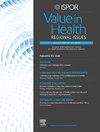Cost-Effectiveness of an Enhanced Patient Care Intervention for Improving Viral Suppression Among Kenyan Adults Living With HIV
IF 1.4
Q3 HEALTH CARE SCIENCES & SERVICES
引用次数: 0
Abstract
Objectives
Patient-centered interventions can improve care engagement and treatment adherence for people living with HIV (PLWH). Yet, evidence on their cost-effectiveness remains sparse, hindering their prioritization over alternative models. This study estimated the cost-effectiveness of a patient-centered intervention for improving viral suppression among PLWH in western Kenya.
Methods
We analyzed the cost-effectiveness of an enhanced patient-centered (EPC) intervention via a randomized pilot trial among 328 PLWH in 2 rural clinics. The EPC arm included clinician-patient continuity, treatment dialogue, and flexible scheduling. The provider-patient communication (PPC) arm provided training on motivational interviewing. The standard of care arm provided patient-specific interventions to promote viral suppression. Costs were aggregated across the 2 clinics and measured from a societal perspective, including patient time, transportation, and medication. The incremental cost per disability-adjusted life year averted was calculated based on patient virologic failure risk, HIV transmissions averted, and life expectancy. Key parameters were varied by ±25% to examine uncertainty in incremental cost-effectiveness ratios.
Results
Compared with standard HIV care, both the EPC intervention and PPC training alone were more cost-effective at various willingness-to-pay thresholds. Providing PPC training alone was the dominant strategy (more effective and less costly) compared with the EPC intervention at $97.72 per HIV infection averted and $4.44 per disability-adjusted life year averted. Both interventions were cost savings when factoring in lifetime HIV treatment cost averted.
Conclusions
Patient-centered care models may be highly cost-effective for improving treatment outcomes among PLWH. These encouraging results warrant further testing in fully powered clinical trials.
加强病人护理干预的成本效益,以改善肯尼亚成人艾滋病毒感染者的病毒抑制
目的:以患者为中心的干预措施可以提高艾滋病毒感染者(PLWH)的护理参与度和治疗依从性。然而,关于它们的成本效益的证据仍然很少,阻碍了它们在替代模型上的优先级。本研究估计了以患者为中心的干预措施的成本效益,以改善肯尼亚西部PLWH的病毒抑制。方法通过对2个农村诊所328个PLWH的随机试点试验,分析了一种以患者为中心的强化干预的成本效益。EPC组包括临床患者连续性、治疗对话和灵活的日程安排。医患沟通(PPC)组提供动机性访谈培训。标准护理组提供针对患者的干预措施以促进病毒抑制。成本是两家诊所的总和,并从社会角度进行衡量,包括患者时间、交通和药物。每个残疾调整生命年的增量成本是根据患者病毒学失败风险、避免艾滋病毒传播和预期寿命计算的。关键参数变化±25%,以检验增量成本-效果比的不确定性。结果与标准HIV护理相比,EPC干预和单独PPC培训在各种支付意愿阈值上都更具成本效益。与EPC干预相比,单独提供PPC培训是主要策略(更有效,成本更低),每个避免艾滋病毒感染为97.72美元,每个避免残疾调整生命年为4.44美元。考虑到避免的终生艾滋病毒治疗费用,这两种干预措施都节省了费用。结论以患者为中心的护理模式可提高PLWH患者的治疗效果。这些令人鼓舞的结果值得在全面的临床试验中进一步测试。
本文章由计算机程序翻译,如有差异,请以英文原文为准。
求助全文
约1分钟内获得全文
求助全文
来源期刊

Value in health regional issues
Pharmacology, Toxicology and Pharmaceutics-Pharmacology, Toxicology and Pharmaceutics (miscellaneous)
CiteScore
2.60
自引率
5.00%
发文量
127
 求助内容:
求助内容: 应助结果提醒方式:
应助结果提醒方式:


